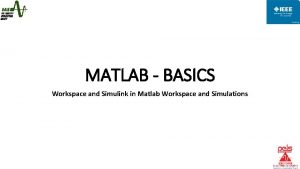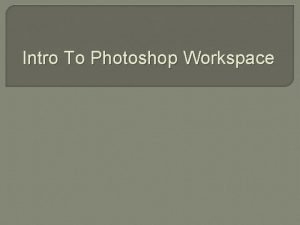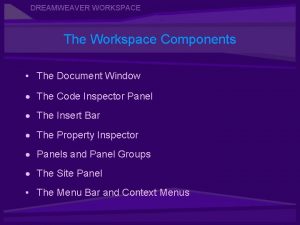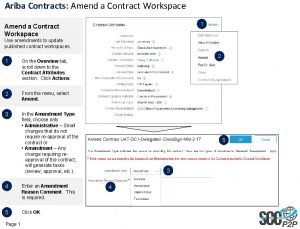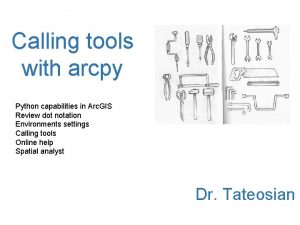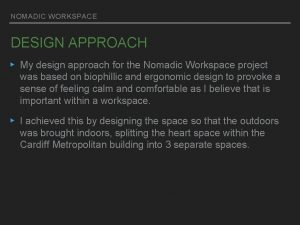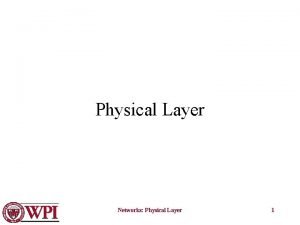WORKSPACE ENVELOPS WHAT IS WORKSPACE Physical design of

























- Slides: 25

WORKSPACE ENVELOPS

WHAT IS WORKSPACE? � Physical design of a workspace includes working out how much space needed, and positioning of furniture, tools, equipment and any other items needed to perform the tasks, in respect of posture, access, clearance, reach and vision of the user. �A poorly designed workspace, or a bad arrangement of furniture or equipment, may result in injuries and strains due to adoption of uncomfortable working postures, less 'spare' capacity to deal with unexpected events or emergencies, the increased possibility of errors or accidents, and inefficiency

WORKSPACE FACTORS � � find the answers to the following questions when designing workspaces: What type of task will be carried out and what specific actions are to be used to complete the task? � Will the potential users of the workspace (your user population) be seated or standing? � What postures will the users have to adopt? � What are the relevant body dimensions of the users? These dimensions can be found in anthropometric tables. (Read the anthropometry topic for more information. ) � Do you need to design using minimum, average or maximum dimensions? � How far can the users reach, horizontally and vertically? � What are the visual aspects of the task? � It may also be necessary to consider factors such as how long the task will take, the environmental conditions that the task is performed under (lighting, temperature, noise levels), and the experience that the users have of performing the task.

Body dimensions � Using anthropometric data � People vary both in their body dimensions and proportions. � � Body size varies with age, gender, nationality, ethnic origin, occupation (as people of a certain size are often more suited to certain occupations, for example, truck drivers tend to be larger males), as well as other factors such as body type (muscular, thin etc) and disability. � It is critical that when you are designing for a specific group, you must use workspace data that is specific to them.

� In general, this tends to be a broad spectrum of users. � However, a workspace may be designed to be used by a restricted group of users, for example, drivers of fire fighting vehicles (mainly male, 30 -50 years old), or be designed to be used by the majority of the adult population, for example, drivers of private cars (both male and female, 17 -70+ years old). � Allowances should also be made if special clothing or personal protective equipment, such a hard hats or gloves, needs to be worn. � These may restrict motion and reach in certain directions, or require greater clearances, for example, people who need to wear boots will need more foot room.

DESIGNING FOR THE 'AVERAGE' � It is important to realise that there is no 'average' individual. You may be 'average' for one or two body dimensions, say arm length and height, but generally that is all. � Designing for the average user is often seen as bad design, as it only accommodates 50% of a population, however, there a few cases where it is appropriate. � Designing for the extreme or with maximum adjustability may not be practical, and designing for the 50 th percentile may be the only way to reach a compromise with other design factors, for example, cost, time and space. � An example is the counter height on a supermarket checkout. This is designed for the 50 th% percentile because it is important for it not to be too high OR too low, and because adjustability is not feasible.

DESIGNING FOR ADJUSTABILITY � Wherever possible, it is best to design adjustability into any workspace. � An example is the interior of a car, where the driver's seat has height adjustment, and forwards and backwards adjustment, to comfortably fit as many users as possible. � For an adjustable range, we generally use: - 5 th percentile female for the lower limit, - 95 th percentile male for the upper limit.

DESIGNING FOR EXTREME INDIVIDUALS � In some situations a specific dimension of a workspace layout becomes the limiting factor that may restrict the use of the workspace for some people. � This limiting factor can either be designed for the minimum or maximum value for a population, depending upon what is required. . � You should design for the minimum population when the minimum value (lowest) of the feature has to accommodate all users. For example, controls should be within reach of the smallest operator. � You should design for the maximum population when the maximum value (highest) of a feature has to accommodate all users. For example, the height of a doorway should allow all users to pass through without stooping or banging their head! � It is not usually practical to design layouts for all users (100%), so when setting the dimensions for a workspace layout use: - 5 th percentile female for minimum values, - 95 th percentile male for maximum values.

� A 'workspace envelope' is a 3 -dimensional space within which you carry out physical work activities when you are at a fixed location. � The limits of the envelope are determined by your functional arm reach which, in turn, is influenced by the direction of reach and the nature of the task being performed. � Most of the things that you need to use to carry out your tasks should be arranged within this area. � Workspace envelopes should be designed for the 5 th percentile of the user population, which means that 95% of users will be able to reach everything placed within the envelope.

SEATED WORKSPACE � In general, the maximum work area is the area within comfortable reach of your extended arm, while the normal work area is within the limits of a comfortable sweeping movement of your arm, with your elbow bent at a right angle or less. � You should also consider any potential restraint caused by clothing that you might have to wear, as well as personal factors such as age, gender (women have greater flexibility than men), and any disabilities. � The type of task being performed also affects the boundary of the workspace envelope. � For tasks that require the activation of a switch, it is common to use anthropometric measurements from the fingertip reach of the users to set the envelope boundary. However, where a grasping action is involved, the reach of the user is reduced as your fist has to be clenched.

� Some general principles for seated work: Working with relaxed upper arms and elbows at approximately 90° provides comfort and helps maintain straight wrists, which reduces the strain of repetitive tasks. � Adjustable height work surfaces allow each user to fit the work surface to their own needs. If this is not possible, fix the work surface height to be at a level that places the working item, for example, a keyboard, at elbow height. � Make sure that there is adequate clearance for your thighs under the work surface. � Small users whose feet do not touch the floor when seated should have a footrest. � For fine work, requiring better visibility, the work surface can be raised, but elbow support must be provided.


STANDING WORKSPACE � The limit of the workspace envelope for a standing user can be seen as the space in which an object can be reached and gripped comfortably, when you are standing up straight. � Your arms and hands are most powerful when your elbows are close to your sides and bent at right angles or more, that is, extended slightly. � The work surface should allow this kind of posture for manual work requiring strength. � For precise, fine work, as well as for writing, drawing and reading, the work surface should be higher so that the elbows can be rested on it. This will also bring the work closer to your eyes.

� Some general principles for standing work: � For work that requires the application of force from the shoulder and back muscles, the work surface should be about 100 -250 mm lower than the level of the elbows. � For normal tasks that do not require much strength, the worktop should be about elbow height or just below. � For precision work, the work surface should be about 50 -100 mm above elbow height. � Precision work should preferably be done sitting, when the back muscles should be supported and relieved by suitable seating and elbow support. The provision of high stools allow users to alternate between a standing and a 'perched' position. � Adjustable height work surfaces allow each user to fit the work surface to their own needs. If this is not possible, design for the largest user, and supply platforms to those that are smaller.

MAXIMUM VERTICAL AND HORIZONTAL REACH � Vertical reach is limited by how far you can reach and grasp objects above or below your shoulder height without stretching or bending. � Measurement of vertical reach is taken from the surface of your shoulder to the centre of your closed hand (or extended middle finger for button operation). � Height of reach is used when positioning shelves for storage, handles or controls above head height. � Horizontal reach is measured in the same way, but about the horizontal plane.

GUIDELINES FOR THE DESIGN OF WORKSPACES � Encourage a frequent change in posture People involved in seated work should be encouraged to change posture and sit in a variety of positions. � Most modern office chairs help to promote this sort of behaviour. For industrial tasks, 'sitstand' workspaces are advisable, whereby the task is set at a height that is suitable for standing at, but a high stool is also provided for support. � Avoid forward bending of head and trunk This is common during visual tasks, and where the work surface is too low. For fine visual work, consider sloping the worksurface towards you. � Avoid causing the arms to be held in a raised position This is common where the work surface is too high, or the seating is too low. � If, usually for visual reasons, the task should be performed in a raised position, then elbow support should be provided. A lack of support leads to stress on the shoulder muscles, and an extra circulatory burden on the heart.

� Avoid twisted and asymmetrical positions These are most common when displays or controls are poorly located. Frequently used items should be placed centrally between waist and shoulder height to reduce the need to bend or twist to reach. � Avoid postures that require a joint to be used for long periods of time at the limit of its range of motion This is particularly important for the wrist and forearm. Make sure that items that are often used are within easy reach. � Provide adequate back support for all seats If, due to operational reasons, the user is not using the back support, it should still be provided in order to give support during rest periods. � � Where muscular force must be exerted the limbs should be in a position of greatest strength The muscles and joints work best when they are in the mid-third of their range. Position items so that the arms can be used in this way. Test your workspace layouts Make sure that you have designed the workspace well by trying it out on a range of users performing relevant tasks.

ERGONOMICS – DESIGNING THE JOB TO FIT THE WORKER � Ergonomics is the science of designing a job to fit the worker, rather than physically forcing the worker’s body to fit the job. By adapting tasks, work stations, tools, and equipment to fit the worker, ergonomics seeks to reduce physical stress on a worker’s body and eliminate many potentially serious, disabling work-related musculoskeletal disorders (MSDs). � If work tasks and equipment do not include ergonomic principles in their design, workers may have exposure to undue physical stress, strain, and overexertion, including vibration, awkward postures, forceful exertions, repetitive motion, and heavy lifting.

REVIEW TASKS FOR RISK FACTORS

SOURCE: ELEMENTS OF ERGONOMICS PROGRAMS, A PRIMER BASED ON WORKPLACE EVALUATIONS OF MUSCULOSKELETAL DISORDERS

Control risk factors S with engineering and administrative controls, and personal equipment, where it is effective �




 Conceptual design vs physical design
Conceptual design vs physical design Putting service pricing into practice
Putting service pricing into practice What is physical fitness test in mapeh
What is physical fitness test in mapeh Translation workspace
Translation workspace Office live word
Office live word Solis mail uu
Solis mail uu Perforce jam
Perforce jam Simulink to workspace
Simulink to workspace Cisco commerce workspace
Cisco commerce workspace Flash workspace
Flash workspace Ariba contract compliance
Ariba contract compliance Translation workspace
Translation workspace Windchill workspace
Windchill workspace Refinitiv workspace web
Refinitiv workspace web Parts of photoshop workspace
Parts of photoshop workspace Dreamweaver document window
Dreamweaver document window Contract workspace
Contract workspace Oracle workspace manager
Oracle workspace manager Clear command window - matlab
Clear command window - matlab Matlab syntax
Matlab syntax Matlab csv to mat
Matlab csv to mat Crear workspace eclipse
Crear workspace eclipse Jstor workspace
Jstor workspace Emory workspace
Emory workspace Workspace open source
Workspace open source Arcpy.env.workspace
Arcpy.env.workspace







